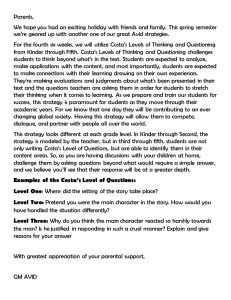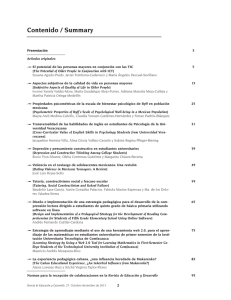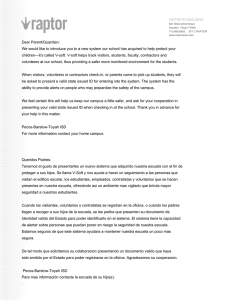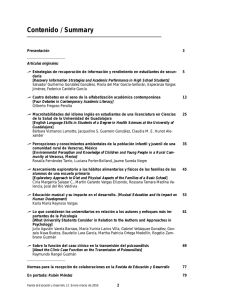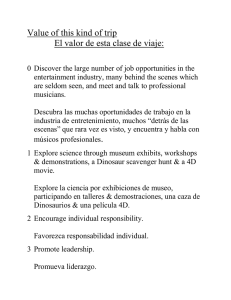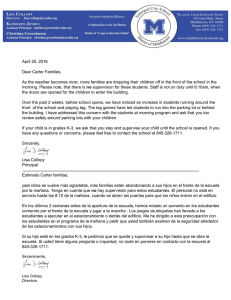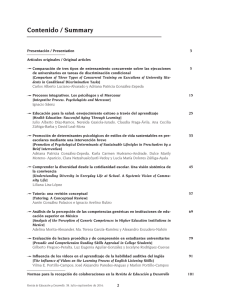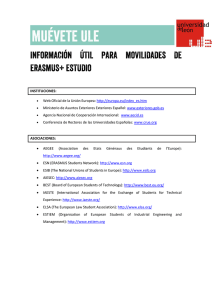Para estudiar mejor . . .
Anuncio
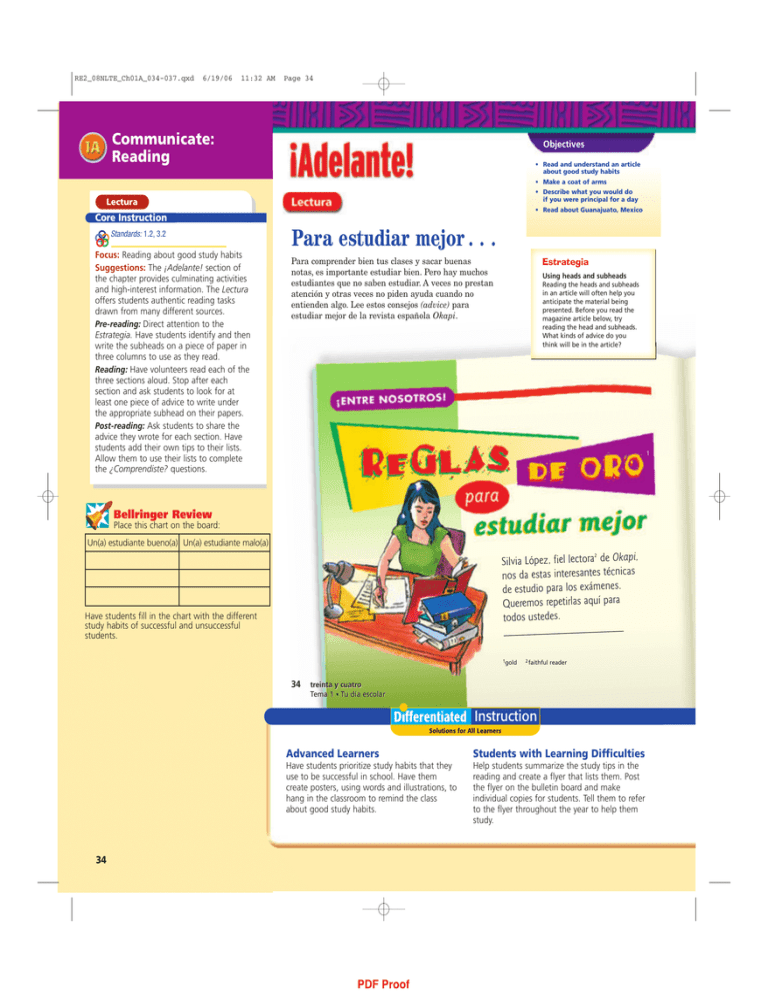
RE2_08NLTE_Ch01A_034-037.qxd 6/19/06 11:32 AM Page 34 Communicate: Reading Objectives • Read and understand an article about good study habits • Make a coat of arms • Describe what you would do if you were principal for a day Lectura • Read about Guanajuato, Mexico Core Instruction Standards: 1.2, 3.2 Focus: Reading about good study habits Suggestions: The ¡Adelante! section of the chapter provides culminating activities and high-interest information. The Lectura offers students authentic reading tasks drawn from many different sources. Pre-reading: Direct attention to the Estrategia. Have students identify and then write the subheads on a piece of paper in three columns to use as they read. Reading: Have volunteers read each of the three sections aloud. Stop after each section and ask students to look for at least one piece of advice to write under the appropriate subhead on their papers. Post-reading: Ask students to share the advice they wrote for each section. Have students add their own tips to their lists. Allow them to use their lists to complete the ¿Comprendiste? questions. Para estudiar mejor . . . Para comprender bien tus clases y sacar buenas notas, es importante estudiar bien. Pero hay muchos estudiantes que no saben estudiar. A veces no prestan atención y otras veces no piden ayuda cuando no entienden algo. Lee estos consejos (advice) para estudiar mejor de la revista española Okapi. Estrategia Using heads and subheads Reading the heads and subheads in an article will often help you anticipate the material being presented. Before you read the magazine article below, try reading the head and subheads. What kinds of advice do you think will be in the article? 1 Bellringer Review Place this chart on the board: Un(a) estudiante bueno(a) Un(a) estudiante malo(a) 2 Silvia López, fiel lectora de Okapi, nos da estas interesantes técnicas de estudio para los exámenes. Queremos repetirlas aquí para todos ustedes. Have students fill in the chart with the different study habits of successful and unsuccessful students. 1gold 34 34 2 faithful reader treinta y cuatro Tema 1 • Tu día escolar Advanced Learners Students with Learning Difficulties Have students prioritize study habits that they use to be successful in school. Have them create posters, using words and illustrations, to hang in the classroom to remind the class about good study habits. Help students summarize the study tips in the reading and create a flyer that lists them. Post the flyer on the bulletin board and make individual copies for students. Tell them to refer to the flyer throughout the year to help them study. RE2_08NLTE_Ch01A_034-037.qxd 6/19/06 11:32 AM Page 35 Communicate: Reading ¿Comprendiste? 1. ¿Cierto o falso? No es necesario estudiar a la misma hora todos los días. 2. ¿Según el artículo, es importante ser una persona organizada? 3. ¿Qué consejos del artículo ya (already) practicas? 4. ¿Qué piensas de estos consejos? ¿Son fáciles de seguir (to follow) en tu casa? 5. ¿Qué otros consejos para estudiar mejor les puedes dar a tus compañeros? Más práctica WAV Wbk.: Writing, p. 15 Guided Practice: Lectura, p. 31 ● Real. para hispanohablantes, pp. 22–23 ● ● Okapi es una revista publicada en España para jóvenes. Tiene artículos sobre el mundo de hoy: los estudios, la vida social, la música, la escuela. Hay secciones dedicadas a las ciencias, los deportes, la historia, la tecnología, los libros y mucho más. Las actividades y los consejos pueden interesar a todos. ¿Comprendiste? Standards: 1.2 ANSWERS Resources: Answers on Transparencies Focus: Verifying reading comprehension Suggestions: If you had students create lists as they read the Lectura, allow them to use these as they answer the questions. Encourage students to answer in complete sentences, even if the answer requires only a “yes” or “no” answer. Answers: • ¿Lees una revista similar a Okapi? ¿Qué tipo de información hay en las revistas que tú lees? For: Internet Activity Web Code: jdd-0106 1. Falso. Es necesario establecer un horario fijo para estudiar. 2. Sí, es importante ser una persona organizada. 3. Answers will vary. 4. Answers will vary. 5. Answers will vary. ¿Qué debes hacer a la hora de estudiar? Para estudiar mejor necesitas una buena organización del trabajo y unos hábitos saludables. Siempre debes ser positivo. Repite frases com3 o “yo puedo hacerlo” o “soy capaz ”. 4 Cuida tus libros y otros materiales. Generalmente una persona constante, organizada y trabajadora tiene buenos resultados en los estudios. s debes planear unos pequeños descanso ndes de 5 a 10 minutos. Y si no entie algo, pide ayuda: ¡Tus padres o tus hermanos mayores te pueden ayudar! Standards: 1.2, 2.2, 4.2 ¿Cómo puedes estudiar mejor y sacar buenas notas? Suggestions: If possible, bring in copies of Okapi or similar magazines, or find online versions on the Web. Ask students to skim the magazines and describe the types of articles they see. Have students bring in magazines they like to read to use as a reference when answering the Fondo cultural question. Answers will vary. Tienes que cuidarte. Debes comer bien y dormir lo suficiente. Por ejemplo, no es bueno estudiar muy tarde por la noche antes de un examen. Debes estar tranquilo, sin estar ni nervioso ni ansioso. La ¿Cómo puedes organizar te tranquilidad emocional te para estudiar? ayuda a pensar mejor. Establece un horario fijo para estudiar También tienes que cuidar tu y planifica tu tiempo. Tienes que pasar vista:5 cuando lees, el libro debe estar suficiente tiempo para llegar al punto a 35–40 cm de distancia de tus ojos y bién Tam . ción de máxima concentra siempre debes usar una buena lámpara. 3 capable 4 Take care of Pre-AP* Support 5 vision treinta y cinco Capítulo 1A Enrich Your Teaching Resources for All Teachers Teacher-to-Teacher Write all of the rules mentioned in the reading on individual pieces of paper, making enough copies so that everyone in the class has one rule. Have students work in groups. Tell one student to act out a rule while the others try to guess which one it is. To encourage variety, have some students act out what not to do. Activity: Divide students into groups of three. Assign each of the three students one of the subtitled sections to read silently and then write a multiple choice question about it. Finally, have each student read aloud his or her section while the group members follow along. Once all sections have been read, have them ask each other their multiple-choice questions. • Pre-AP* Resource Book: Comprehensive guide to Pre-AP* reading skill development, pp.18–24 • 35 For Further Reading Student Resources: Realidades para hispanohablantes, pp. 24–25 Lecturas para hispanohablantes 2, “Cuaderno de tareas,” pp. 68–70 • Guided Practice: Lectura, p. 31 AP* Literature Author: Antonio Machado, Lecturas para hispanohaPre-AP* blantes 2, “Recuerdo infantil,” p. 72 • • 35 RE2_08NLTE_Ch01A_034-037.qxd 6/28/06 10:31 AM Page 36 Communicate: Culture La cultura en vivo Core Instruction Standards: 1.2, 1.3, 2.2, 3.1 Focus: Creating a coat of arms for the school Suggestions: The La cultura en vivo sections introduce students to cultural products of the Spanish-speaking world. In alternate chapters, there is the Perspectivas del mundo hispano, which presents cultural perspectives. Bring in samples of coats of arms from history books or find university logos that contain coats of arms. Ask students to point out symbols and colors and give their opinions about why they think they were chosen. If possible, bring in your own family coat of arms and explain the symbols to students. Ask interested students to research the meanings of various colors and symbols in heraldry (the study of coats of arms and emblems). Ask the woodshop teacher at your school to make you a blank coat of arms. Have the class vote on the best coat of arms and allow the winning group to transfer their drawing onto the wood. Hang the winning coat of arms in the classroom. Extension: Have students research their family coat of arms. Ask volunteers to present their coat of arms and explain how they symbolize the history of their family. Un nuevo escudo de armas Los escudos de armas1 son una manera antigua de identificar a las familias importantes o a los reyes 2. Los escudos tienen símbolos, animales y colores que representan a la familia. Hoy, muchas familias continúan usando los escudos de armas. Muchas compañías, universidades y escuelas también usan escudos de armas que son una versión moderna de esta manera de identificación. ¡Compruébalo! ¿Tiene tu escuela un escudo de armas? Investiga si tu escuela tiene uno y cuál es su significado. Objetivo Haz un escudo de armas para tu escuela. Si tu escuela tiene uno, haz otro nuevo. Figura 1 Éste es el escudo del Reino de España. En la parte de arriba está la corona (crown) de los reyes. Materiales • hojas grandes de papel • lápices de colores Instrucciones Trabaja con un grupo de tres o cuatro estudiantes. 1 Piensen en los símbolos de su escuela. ¿Cómo pueden usar estos símbolos en su nuevo escudo? 2 Dibujen la forma de un escudo o hagan una copia del escudo en la Figura 2. 3 Escojan tres o más símbolos. 4 Escojan tres o más colores. 5 Escojan un lema3 en español para la escuela, por ejemplo, Siempre listos o Salud, trabajo y bienestar. Teacher-to-Teacher e-amigos: Pair students to be e-amigos. Have them socialize by sending each other e-mails. Ask them to introduce themselves and to exchange information about their classes. Encourage them to ask questions about their partner’s classes. Have students print out their e-mails or send them to you for your review. 6 Dibujen el escudo y preséntenlo a la clase. 1coats of arms 2kings 3slogan Figura 2 36 treinta y seis Tema 1 • Tu día escolar Additional Resources Student Resource: Realidades para hispanohablantes, p. 26 36 Advanced Learners Students with Learning Difficulties Have students search the Web for information on the official coat of arms of Spain or of the royal family. Have them write a report explaining how the symbols reflect the history of the country. To help students prepare for their oral presentation, encourage those with oral expression difficulties to tape-record or videotape a practice presentation. They can then play it back and make appropriate adjustments to their rate, intonation, volume, and nonverbal gestures. RE2_08NLTE_Ch01A_034-037.qxd 6/19/06 11:33 AM Page 37 Communicate: Speaking Director(a) por un día Presentación oral Core Instruction Task You have been invited to be principal for a day. Your first task is to create some new school rules and display them on a poster. Be creative! After you complete the poster, present it to the class. Standards: 1.3, 3.1 1 Prepare Make a list of six new school rules. Include three things students must do and three that are not allowed. You want to create a very supportive environment where people will learn better. Then make a poster to illustrate your rules. Estrategia Brainstorming 2 Practice Using the illustrations on your poster, go through your presentation several times. You can use your notes when you practice, but not when you present. Be sure to: • include three things that students must do and three things that are not allowed • use complete sentences • speak clearly Before you prepare a presentation, think of all the possible ideas for your project. List all your ideas, without judging whether they are good or bad. Then go back and review your list. Pick the best ones for your presentation. Modelo Éstas son mis reglas nuevas: Todos los estudiantes deben hacer preguntas si no entienden algo. Y hay que . . . ¡Se prohíbe hablar inglés en la clase de español! Y tampoco deben . . . Portfolio Record students’ oral presentations on cassette or videotape for inclusion in their portfolios. 3 Present Tell your classmates your new school rules, using the visuals on your poster. 4 Evaluation Your teacher may give you a rubric for how the presentation will be graded. You probably will be graded on: • how complete your presentation is • how easy it is to understand you • how clearly the visuals on your poster illustrate your rules Pre-AP* Support • Student Resources: Realidades para hispanohablantes, p. 27; Guided Practice: Presentación oral, p. 32 37 Enrich Your Teaching Resources for All Teachers Score 1 Pre-AP* Resource Book: Comprehensive guide to Pre-AP* speaking skill development, pp. 36–46 Additional Resources treinta y siete Capítulo 1A RUBRIC Focus: Speaking about appropriate and inappropriate school behavior Suggestions: The Presentación oral helps students learn to build oral presentations of many sorts using a four-step approach. In alternate chapters, there is a parallel Presentación escrita. To help students brainstorm, suggest that they think about the rules in their own school. Are there any rules that don’t work? Are there some that could be improved? Also encourage students to think about problems in school that could be prevented by rules. Review the four-step approach with students. Emphasize the importance of planning and practicing for an oral presentation. Remind students to use their visual presentation to help organize their oral presentation. Score 3 Score 5 Completeness of your task You provide some of the information required. You provide most of the information required. You provide all of the information required. How easily you are understood You are difficult to understand and have many grammatical errors. You are fairly easy to understand and have occasional grammatical errors. You are easy to understand and have very few grammatical errors. How clearly your visuals match your rules You provide four visuals that clearly match your rules. You provide five visuals that clearly match your rules. You provide six visuals that clearly match your rules. Assessment • Assessment Program: Rubrics, p. T27 Give students copies of the rubric before they begin the activity. Go over the descriptions of the different levels of performance. After assessing students, help individuals understand how their performance could be improved. 37 RE2_08NLTE_Ch01A_038-039.qxd 6/19/06 11:34 AM Page 38 Culture Las estudiantinas de Guanajuato son grupos de jóvenes que pasean cantando y caminando por las calles. Llevan trajes de diferentes colores y tocan instrumentos musicales. Videomisterio Core Instruction Preparación para . . . Standards: 1.2, 3.2, 5.2 Resources: Voc. and Gram. Transparencies: Map 12 Focus: Reading about Guanajuato to prepare for the Videomisterio Suggestions: Before reading the introductory paragraph, have students find Guanajuato on the map. Have students locate Mexico City, the Pacific Ocean, the Gulf of Mexico, and the United States. Point out that Guanajuato, the capital city of the state of Guanajuato, is bordered on the north by the Sierra Central region, which includes San Miguel de Allende and Dolores Hidalgo, two other cities students will get to know in the Videomisterio. To give students perspective on the size of Guanajuato, have them research the population of their town or city, as well as various cities in their state. Direct attention to the photo of las estudiantinas. Explain that these are student groups that dress in medieval attire and stroll through the streets singing and playing their music. This custom is based on the Spanish tradition of las tunas. The tradition was brought to Guanajuato in 1963, and today it is an important part of the culture of the city. Large groups of people follow the musicians as they tour the city’s narrow streets singing songs and telling stories. Point out the photo of the Bocamina de la Valenciana mine and ask students if they have ever visited a mine. If so, where? What was it like? Ask students to look at the photo of El Pípila, and ask them to predict its actual size. Tell them that the statue is 26 meters (85 feet) tall. Explain that Juan Olaguíbel built it in 1939 and that it contains an interior staircase that visitors can use to climb to the top. Point out that the Alhóndiga de Granaditas is a fortress that was built between 1798 and 1809, and was the site of one of the first battles for Mexican independence from Spain. 38 Guanajuato Bienvenidos a Guanajuato, lugar principal del Videomisterio. A unos 450 kilómetros al noroeste de la Ciudad de México, Guanajuato tiene una población de más de 141,000 habitantes y es una ciudad con mucha historia. En los dos primeros Temas, van a conocer algunos lugares que tienen importancia en el video En busca de la verdad. Van a empezar a ver el video con el Tema 3. Esta bella ciudad tiene una hermosa arquitectura del período colonial (siglos1 XVI a XVIII). Esto fue posible gracias a la riqueza2 de sus minas durante la colonización española de México. Estas minas hicieron de Guanajuato una ciudad muy importante, con costumbres y tradiciones españolas. Hoy en día, Guanajuato todavía es una de las ciudades mexicanas más importantes en la producción de plata3. Sus minas, tal como la Bocamina de la Valenciana, son lugares de mucho valor histórico y cultural. Guanajuato es famosa por sus grandes héroes y batallas de la independencia mexicana (1810–1821). “El Pípila” es un monumento en homenaje al minero Juan José Martines de los Reyes. En 1810 él se convirtió en héroe cuando le prendió fuego 4 a la puerta de la fortificación española, llamada Alhóndiga de Granaditas. 1centuries 38 2 riches 3silver 4 set fire treinta y ocho Tema 1 • Tu día escolar Advanced Learners Students with Learning Difficulties Have students search the Internet to find studyabroad programs that offer summer classes at the Universidad de Guanajuato. Ask them to choose a program and write a report describing what classes they would like to take and where they would like to live. Have them include information about cost, lodging, and dates. Students may have difficulty putting the dates in Mexican history into perspective. Give them a timeline with important dates in American history and have them use a colored pencil to write in the historical dates mentioned in the reading. Encourage them to add dates to the timeline when viewing Videomisterio episodes. RE2_08NLTE_Ch01A_038-039.qxd 6/19/06 11:34 AM Page 39 Culture Guanajuato es famosa por sus estrechas y empedradas 5 calles, llamadas callejones. También es un gran centro artístico, intelectual y cultural. Aquí nació el muralista Diego Rivera. Hay una respetada universidad en el centro. También hay una gran cantidad de museos, algunos artísticos, como el Museo Iconográfico del Quixote, y otros raros 6, como el Museo de la Momia. Guanajuato celebra cada octubre el Festival Cervantino. Es en honor al escritor español Miguel de Cervantes y llegan personas de todo el mundo. Tijuana ¿Sabes que . . . ? Estados Unidos Ciudad Juárez SI Chihuahua RA SIE ER RR M RE CC ID IE TA este NT L OCÉANO PACÍFICO Guadalajara Querétaro Paricutín La belleza colonial y la vida cultural de Guanajuato atrae a visitantes de todo el mundo. ¿Qué ciudad estadounidense conoces que hace lo mismo? SI Guanajuato AL sur Para pensar ER RA M Mérida Ciudad Iztaccíhuatl de Veracruz México Popocatépetl AD RE Puebla DE Acapulco Frontera nacional Capital Ciudad Volcán o montaña 0 0 Golfo de M éxic o OR EN oeste Monterrey RE México O norte Nuevo Laredo AD A M AD Guanajuato tiene muchas calles subterráneas. Las calles son productos de las viejas minas y antiguos ríos. Éstas permiten que los coches pasen por la ciudad sin afectar la arquitectura colonial y estilo de vida guanajuatense. 300 300 L S Oaxaca UR ISTMO DE TEHUANTEPEC 600 millas 600 kilómetros Belice Guatemala El Salvador Suggestions: Direct attention to the photo of the callejón, a narrow street or alleyway that is typical of the city of Guanajuato. Tell students about the famous Callejón del Beso. Explain that when the estudiantinas get to the Callejón del Beso, they tell a story similar to that of Romeo and Juliet and encourage couples to follow the tradition of kissing at the bottom of the street. Point out the photo of the statues of Don Quixote and Sancho Panza. Ask students if they have ever read anything written by Miguel de Cervantes. Have they ever seen the movie or play, The Man of La Mancha? The festival is one of the most important arts festivals held in a Spanish-speaking country. It attracts nearly 150,000 visitors annually. It has been held in Guanajuato every October since 1972. To help students answer the Para pensar question, have them research colonial cities in the United States. You may prefer to list colonial cities on the board and have students who have visited them give descriptions and explanations for why they are popular among tourists. Answers will vary. Extension: Ask students to choose their favorite colonial city and write a tourist brochure describing the city’s history and attractions. If possible, encourage them to include photos of the city that they took when they visited there, or have them download visuals from the Internet. Assessment • 5 narrow and cobblestoned 6 strange treinta y nueve Capítulo 1A Quiz on PresEXPRESS 39 Enrich Your Teaching Resources for All Teachers Culture Note Internet Search Miguel de Cervantes was one of the greatest writers Spain has ever produced. His most famous work of fiction, Don Quixote, was published when Cervantes was already middleaged. Prior to its publication, Cervantes had been held for a time as a slave in North Africa and had served with distinction in the Spanish Army. Keywords: Festival Cervantino + Guanajuato 39
